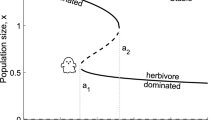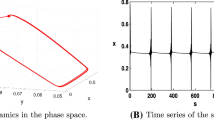Abstract
Ecosystems can experience sudden regime shifts due to a variety of mechanisms. Two of the ways a system can cross a tipping point include when a perturbation to the system state is large enough to push the system beyond the basin of attraction of one stable state and into that of another (state tipping), and alternately, when slow changes to some underlying parameter lead to a fold bifurcation that annihilates one of the stable states. The first mechanism does not generate the phenomenon of critical slowing down (CSD), whereas the latter does generate CSD, which has been postulated as a way to detect early warning signs ahead of a sudden shift. Yet distinguishing between the two mechanisms (s-tipping and b-tipping) is not always as straightforward as it might seem. The distinction between “state” and “parameter” that may seem self-evident in mathematical equations depends fundamentally on ecological details in model formulation. This distinction is particularly relevant when considering high-dimensional models involving trophic webs of interacting species, which can only be reduced to a one-dimensional model of a tipping point under appropriate consideration of both the mathematics and biology involved. Here we illustrate that process of dimension reduction and distinguishing between s- and b-tipping for a highly influential trophic cascade model used to demonstrate tipping points and test CSD predictions in silico, and later, in a natural lake ecosystem. Our analysis resolves a previously unclear issue as to the nature of the tipping point involved.





Similar content being viewed by others
References
Ashwin P, Wieczorek S, Vitolo R, Cox P (2012) Tipping points in open systems: bifurcation, noise-induced and rate-dependent examples in the climate system. Philos Trans Ser A Math Phys Eng Sci 370:1166–84. https://doi.org/10.1098/rsta.2011.0306
Barnosky AD, Ea H, Bascompte J et al (2012) Approaching a state shift in Earth’s biosphere. Nature 486:52–58. https://doi.org/10.1038/nature11018
Batt RD, Carpenter SR, Ives AR (2017) Extreme events in lake ecosystem time series. Limnol Oceanogr Lett 2:63–69. https://doi.org/10.1002/lol2.10037
Boettiger C, Hastings A (2012) Early warning signals and the prosecutor’s fallacy. Proc R Soc B Biol Sci 279:4734–4739. https://doi.org/10.1098/rspb.2012.2085
Boettiger C, Hastings A (2013a) No early warning signals for stochastic transitions: insights from large deviation theory. Proc R Soc B Biol Sci 280:20131372–20131372. https://doi.org/10.1098/rspb.2013.1372
Boettiger C, Hastings A (2013b) Tipping points: from patterns to predictions. Nature 493:157–158. https://doi.org/10.1038/493157b
Boettiger C, Ross N, Hastings A (2013) Early warning signals: the charted and uncharted territories. Theor Ecol. https://doi.org/10.1007/s12080-013-0192-6
Carpenter SR, Brock WA, Cole JJ et al (2008) Leading indicators of trophic cascades. Ecol Lett 11:128–138. https://doi.org/10.1111/j.1461-0248.2007.01131.x
Carpenter SR, Cole JJ, Pace ML et al (2011) Early warnings of regime shifts: a whole-ecosystem experiment. Science 332:1079. https://doi.org/10.1126/science.1203672
Carpenter SR, Brock WA, Cole JJ, Pace ML (2013) A new approach for rapid detection of nearby thresholds in ecosystem time series. Oikos. https://doi.org/10.1111/j.1600-0706.2013.00539.x
Clements CF, Ozgul A (2018) Indicators of transitions in biological systems. Ecol Lett 21:905–919. https://doi.org/10.1111/ele.12948
Dai L, Vorselen D, Korolev KS, Gore J (2012) Generic indicators for loss of resilience before a tipping point leading to population collapse. Science 336:1175–1177. https://doi.org/10.1126/science.1219805
Ratajczak Z, Carpenter SR, Ives AR et al (2018) Abrupt change in ecological systems: inference and diagnosis. Trends Ecol Evolut. https://doi.org/10.1016/j.tree.2018.04.013
Scheffer M, Carpenter SR, Foley JA et al (2001) Catastrophic shifts in ecosystems. Nature 413:591–6. https://doi.org/10.1038/35098000
Scheffer M, Bascompte J, Brock WA et al (2009) Early-warning signals for critical transitions. Nature 461:53–9. https://doi.org/10.1038/nature08227
Scheffer M, Carpenter SR, Lenton TM et al (2012) Anticipating critical transitions. Science 338:344–348. https://doi.org/10.1126/science.1225244
Scheffer M, Carpenter SR, Dakos V, van Nes E (2015) Generic indicators of ecological resilience. Annu Rev Ecol Evolut Syst 46:145–167. https://doi.org/10.1146/annurev-ecolsys-112414-054242
Strogatz SH (2001) Nonlinear dynamics and chaos: with applications to physics, biology, chemistry, and engineering (studies in nonlinearity). Westview Press, Boulder
Wissel C (1984) A universal law of the characteristic return time near thresholds. Oecologia 65:101–107. https://doi.org/10.1007/BF00384470
Acknowledgements
CB acknowledges support in part from USDA National Institute of Food and Agriculture, Hatch project CA-B-INS-0162-H. The authors also wish to acknowledge Alan Hastings, whose off-hand question at a seminar talk inspired the question and analysis considered here.
Author information
Authors and Affiliations
Corresponding author
Additional information
Publisher's Note
Springer Nature remains neutral with regard to jurisdictional claims in published maps and institutional affiliations.
Rights and permissions
About this article
Cite this article
Boettiger, C., Batt, R. Bifurcation or state tipping: assessing transition type in a model trophic cascade. J. Math. Biol. 80, 143–155 (2020). https://doi.org/10.1007/s00285-019-01358-z
Received:
Revised:
Published:
Issue Date:
DOI: https://doi.org/10.1007/s00285-019-01358-z
Keywords
- Tipping point
- Bifurcation
- Saddle-node
- Alternative stable states
- Trophic cascade
- Regime shift
- Trophic triangle




